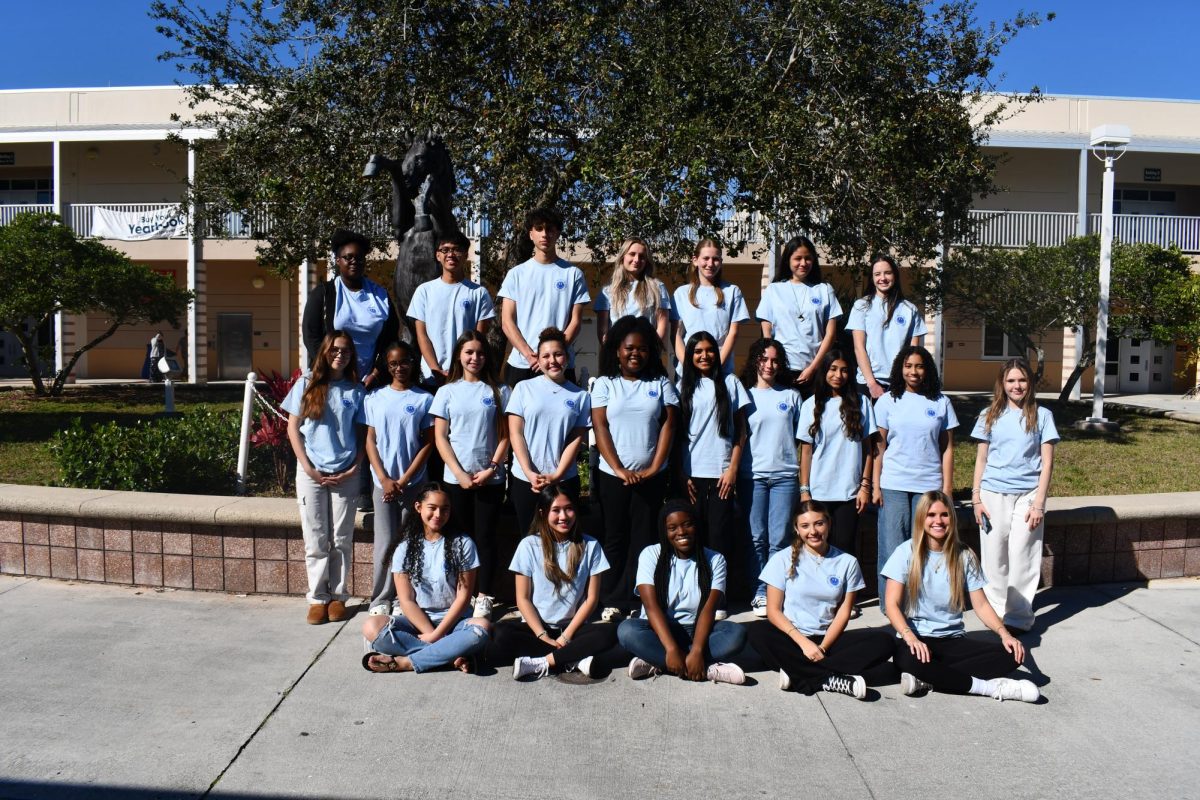The future of transportation is ‘electrifying’
Electric buses are slowly replacing traditional buses driving a more environmentally-friendly school day.
February 28, 2023
Across the country, more and more students find themselves riding in style with electric school buses (ESBs). As these buses grow in popularity (Palm Beach County School District already has 50), they will increasingly play an important role in energy transitions.
In the United States, there are now 12,720 committed electric school buses in 38 states. Half a million school buses now transport 20 million students to school every day with it traveling about 3.4 billion miles per year. A contract was announced at the end of December of 2021 between bus dealer Midwest Transit Equipment and manufacturer of commercial electric vehicles, SEA Electric. This agreement promised to upgrade 10,000 school buses to electric in the next five years – so coming 2026 we will have a more centralized and clean method of transportation for our students.
Why the change to electric buses is important
According to EV Hub, a database for the electrical vehicle industry, about 92-95 percent of school buses run on diesel. A known carcinogen, diesel exhaust has been proven to be linked to physical health and cognitive development issues. Daily exposure has been seen to contribute to asthma, pneumonia, bronchitis, and other respiratory diseases as diesel emissions expose school children to high levels of air pollution.
The World Resource Institute recently reported that students from low-income families are more accessible to diesel exhaust as 60 percent ride the bus to school compared to high-income students with 45 percent. Additionally, school children with disabilities, especially students that are deaf, physically disabled, or have behavioral exceptions, often go through excess travel time because of the loose set of available bus services for them. Students of color are also more likely to suffer from respiratory diseases due to historically racist lending, transit, housing, and zoning policies that had minority communities closer to highways and other places that vehicle-based air pollution is most concentrated in.
“[ESBs] can be important to reduce the amount of air pollution that we are getting,” explained AICE Global Perspectives and AP Environmental teacher, Ms. Kerry Grayson. “However, it depends on the source of electricities so they may be great if the source of electricity, in the first place, for recharging them would be sustainable and renewable but if we are still getting our electricity from our source of coal or natural gas it’s kind of a big thing.”
Reasons why electric buses are better for students
Electric school buses do not have tailpipe emissions, which reduces student exposure to pollutants that contribute to respiratory disease, heart disease, cancer, and physical issues that harm student’s cognitive abilities. Also they have significantly lower greenhouse gas emissions than diesel or propane. The usage of electric buses, unlike other fuels, will help reduce greenhouse gasses from transportation as electricity generators come from renewable energy.
Experiment
ScienceDirect, the world’s leading source of scientific, technical, and medical research examined 2,656 electric school buses across Georgia between 2007 and 2015 to study the effects of emissions reductions on students. This number represents 15 percent of Georgia’s 180 school districts. The measure of exposure was based on the proportion of students who are bus riders and the average amount of time each student was spending on the bus. Student health was observed using the FitnessGram and for scholastic outcomes observed English and math end-of-grade scores in addition to district attendance.
By replacing diesel engines with electric batteries, there was a 5 percent improvement in aerobic capacity of students. Evidence also showed increased English test scores by 10 percent while math scores were also positive but were smaller and fluctuated. Just to put it in perspective, if you got an 85 (B) on a story quiz in Ms. Lezark’s AICE Lit class and they switched your bus to electric, the benefit could be now you would have a 93 (A) on that same quiz. The investigation, however, found little evidence that attendance was significantly affected, though initial attendance was fairly high.
Finally, the results concluded that the installations are a cost-effective method to improving both student health and achievement. Analysis suggests that for each effect, benefits were far in comparison to the price. The average modification required only $8,110 in the sample size which suggests that diesel engine modifications can be at least three-times more effective than the class-size reductions for achieving test score improvements.
Number of electric bus committees and its rising numbers:
The contract between Midwest Transit Equipment and SEA Electric to repower 10,000 electric school buses is, at the moment, the largest single-contract commitment to date. There are, however, large numbers of other fleet operators committed to the distribution of electric school buses.
Top 10 Electric School Bus Funding Sources
| Rank | Funding Source | Funding Administrator | Number of Electric School Buses |
| 1 | California’s Hybrid and Zero-Emission Truck and Bus Voucher Incentive Program (HVIP) | California Air Resources Board (CARB) | 688 |
| 2 | Volkswagen (VW) Settlement | Multiple | 636 |
| 3 | School Bus Replacement Program | California Energy Commission | 251 |
| 4 | Rural School Bus Pilot Program | CARB | 136 |
| 5 | Carl Moyer Program | CARB | 127 |
| 6 | Community Air Protection Incentive Program | CARB | 87 |
| 7 | Regional Greenhouse Gas Initiative | Multiple (MA and NJ) | 65 |
| 8 | Electric School Bus Program | Dominion Energy (VA) | 59 |
| 9 | Airshed Grant | Environmental Protection Agency (EPA) | 42 |
| 10 | Sacramento Regional Zero Emission School Bus Deployment Program | Sacramento Metropolitan Air Quality Management District | 38 |
Source: Lazer and Freehafer, 2022
In a March 2022 report, 42 Florida school districts had 10 or more ESBs compared to the 60 Florida school districts that now have ESBs. This shows a 25 percent increase. The numbers suggest trust in electric buses and their technology as well as their market conditions and funding availability.
Top 5 School Districts by Number of Electric School Buses Committed*
| Rank | Entity name | State | Number of ESBs |
| 1 | Montgomery County Public Schools | MD | 327 |
| 2 | New York City Public Schools | NY | 87 |
| 3 | Twin Rivers Unified School District | CA | 82 |
| 4 | Troy Community Consolidated School District 30-C | IL | 64 |
| 5 | Broward County Public Schools | FL | 60 |
Source: Lazer and Freehafer, 2022
Electric School Buses in Palm Beach District
“No, we do not,” said Assistant Principal Willow Louis when asked if Central has any electric school buses. Louis oversees AVID, English, and bus transportation, and the Language Arts department.
When further asked if he heard anything of electric school buses coming to Central, he responded that it is not happening as of right now. Louis is focusing his attention on finding more bus drivers. Despite there being no ESBs in our near future, Louis does support a switch.
[The ESBs] would save money, fuel costs, engine repair, and also the environment,” he explained. “You know it would be better for the environment but I think to initially have the funds to just have the initial funds of purchase, a fleet of electric school buses, the price would be astronomical.”
Palm Beach Central’s AICE Environmental Management Steven Allen is in agreement with Louis.
“Electric buses are a step in the right direction,” said Allen, who also teaches physics.“They do not emit as much carbon dioxide and, not just carbon dioxide, but nitrogen and dioxides and other things that associate with burning fossil fuels.”
Disadvantages of electric school buses and their solutions
Even though electric school buses are likely to save money in the long run, the initial purchase is considerably high so that alienates poor income schools and communities that can’t afford one, let alone multiple for all their students. This could be offset by different funding options, the district could lend them their buses, taxes could be raised to produce more money for schools, and programs could be built to build up profits by donations.
The second problem is range. The mileage gap between electric buses and the average diesel buses could shrink in following years, but the current gap is still significant enough to place hesitancy in the purchase. Currently, diesel buses travel roughly seven times further on a single tank compared to a single charge. Electric school buses can still travel 100 miles or more on a single charge so it still holds promise. This could be helped by experimenting more on electric vehicles and finding ways to preserve more on the charge and or make the charge bigger. Electric school buses take two to three hours to fully charge and so there could be electronic chargers in every school to then charge the buses needed and then switch them out for a fully charged one. No doubt this would take a full set of electric school buses but this change will happen, if not slow in years to come.
“A lot of the electricity used to charge the buses comes from sources that are not as clean: coal, power plants,” Allen added.
Conclusion
EPA’s new clean school bus program has provided $5 billion over the next five years (2022-2026) with the goal of replacing existing school buses with zero-emission and low-emission models.
“[ESBs] are not perfect,” Allen explained. “We do not have charging stations everywhere, I assume, for buses that I believe would fix that issue quite quickly, but electric technology for electric vehicles has not expanded enough. In Florida, however, we get most of our energy from other places like natural gas, we have nuclear reactors and whatnot, but it’s a step in the right direction.”




